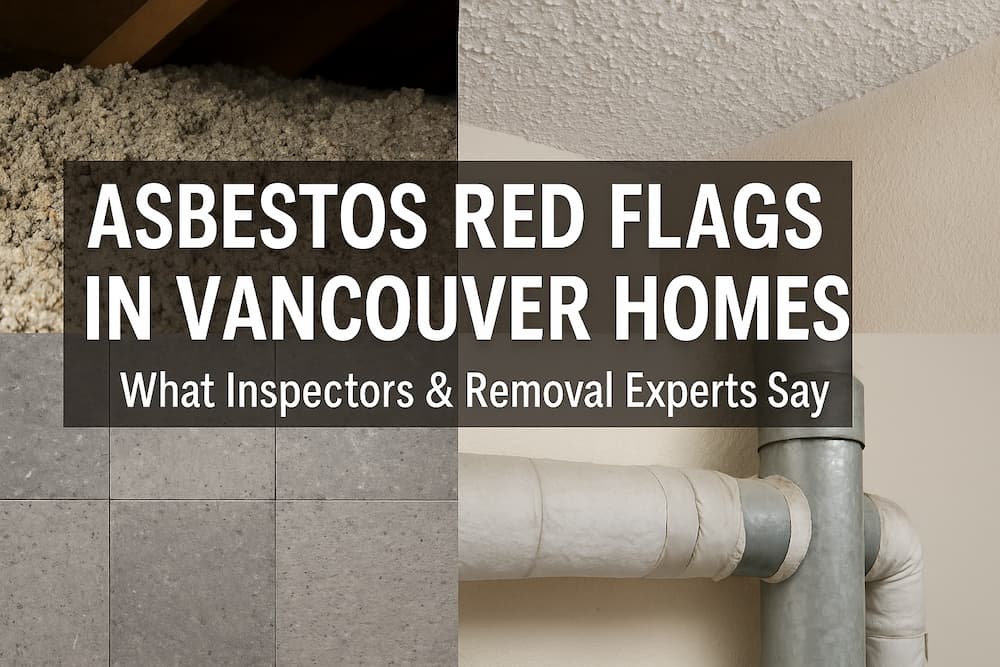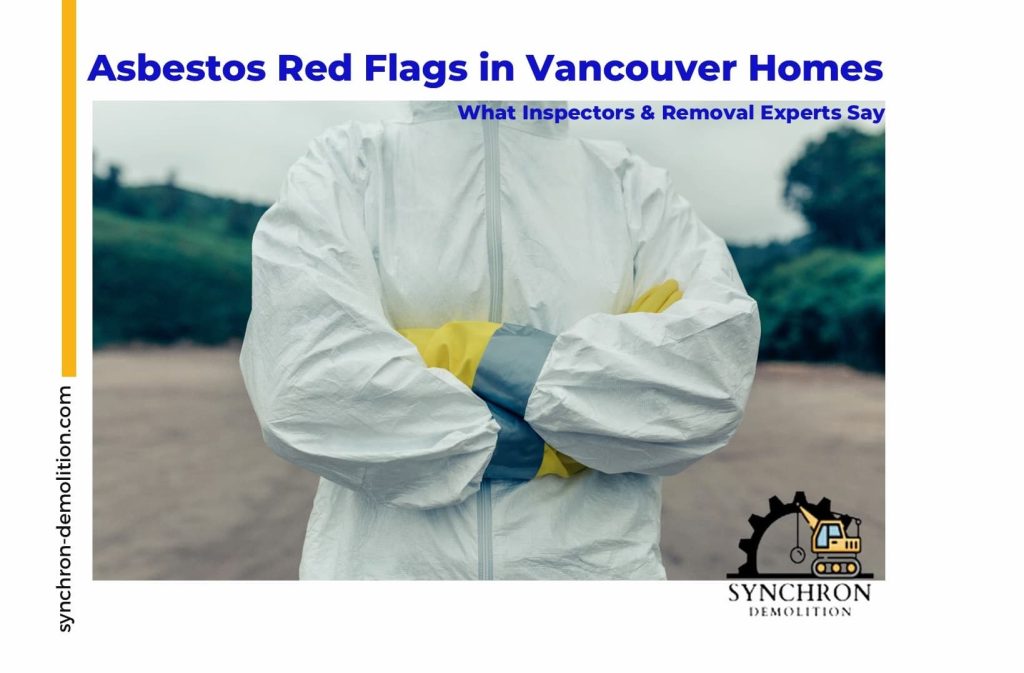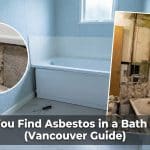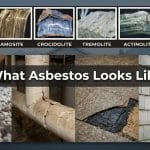When buying, selling, or renovating a home in Vancouver—especially one built before the 1990s—there’s one hidden hazard that continues to raise alarms: asbestos. It’s a health risk, a renovation obstacle, and a legal concern that homeowners can’t afford to overlook. Fortunately, experts in the field, from seasoned home inspectors to certified abatement professionals, are trained to spot the warning signs early.
At Synchron Demolition, we’ve worked with countless Vancouver homeowners, contractors, and real estate professionals to safely identify and remove asbestos from properties of all types.

In this post, we’ll walk through the most common asbestos red flags flagged during inspections, explain how removal professionals assess risks, and provide clear next steps if you suspect asbestos in your home.
Why Asbestos Is Still a Major Issue in Vancouver Homes
Asbestos was once a miracle material—fire-resistant, durable, and cheap—which made it a go-to additive in building materials through much of the 20th century. In Vancouver, a city rich in mid-century homes and character properties, these materials still lurk behind walls, above ceilings, and beneath flooring.
Despite Canada’s asbestos ban in 2018, older homes continue to pose health risks—especially when materials are disturbed during renovations, demolition, or even minor repairs. Inhalation of asbestos fibers is linked to serious illnesses including asbestosis, mesothelioma, and lung cancer.
Top Asbestos Red Flags Identified by Home Inspectors
Professional home inspectors in Vancouver often encounter the following materials that may contain asbestos:
-
Vermiculite Insulation
Found in attics, this loose-fill insulation may contain asbestos—especially if it’s the “Zonolite” brand. -
Popcorn or Textured Ceilings
Decorative ceilings popular in the 1950s–1980s often include asbestos as a binder. -
Vinyl Floor Tiles (especially 9×9)
These tiles, typically found in basements, kitchens, or entryways, are a red flag due to frequent asbestos content in the backing or adhesive. -
Drywall Joint Compound and Plaster
Applied during construction, many joint compounds and plasters used before the 1990s contain asbestos. -
HVAC Duct Tape and Pipe Wrapping
Older heating systems and plumbing may be wrapped in asbestos insulation to retain heat. -
Cement Siding and Shingles
Especially on older bungalows and wartime houses, asbestos cement products are durable—but dangerous if broken or removed. -
Boiler and Furnace Insulation
Some older systems are still surrounded by thick, fibrous asbestos insulation blankets.
What Asbestos Removal Experts Want You to Know
While inspectors can raise concerns, only a certified asbestos professional can confirm the presence of asbestos through lab analysis. At Synchron Demolition, we’ve seen firsthand how common—and how overlooked—these risks can be.
Here’s what our removal experts emphasize:
-
Intact isn’t always safe: While undisturbed asbestos may pose less risk, planned work nearby can still release fibers.
-
DIY is dangerous: Improper handling can lead to airborne contamination, fines, and long-term health consequences.
-
Regulations matter: Vancouver and WorkSafeBC have strict asbestos abatement rules that must be followed before demolition or renovation.
What to Do If You Suspect Asbestos
-
Stop any demolition or remodeling work.
-
Consult a licensed asbestos testing professional.
-
Get lab results to confirm presence.
-
Engage a certified abatement contractor for removal or encapsulation.
-
Ensure compliance with WorkSafeBC and City of Vancouver regulations.
Real Estate Considerations
Asbestos doesn’t just pose a physical risk—it can affect property value, buyer confidence, and legal obligations:
-
Disclosure Required: Sellers must disclose known asbestos hazards.
-
Buyer Risk: Asbestos can derail financing or insurance approval.
-
Inspection Opportunity: Pre-purchase inspections are critical for older homes and condos.
If asbestos is discovered, it doesn’t mean a deal-breaker, but it does require clear communication and a professional plan of action.
Frequently Asked Questions (FAQ)
-
How do I know if my home has asbestos?
Only lab testing can confirm asbestos. Materials commonly suspected include old insulation, flooring, and textured ceilings. -
Is asbestos dangerous if left undisturbed?
Generally, asbestos is less risky when sealed or intact, but renovation or aging materials can make it hazardous. -
Can I remove asbestos myself in Vancouver?
No. WorkSafeBC regulations prohibit unlicensed removal due to safety risks. Professional removal is required. -
How much does asbestos removal cost in Vancouver?
It depends on the scope—small jobs may cost under $2,000, while large-scale abatement can exceed $10,000. -
What is the timeline for asbestos removal?
Most projects are completed in 1–5 days, depending on size and complexity. -
Do I need to vacate my home during removal?
Often, yes—especially for larger jobs or if air quality will be affected during work. -
Is asbestos found in newer homes?
It’s rare in homes built after 1990, but not impossible—especially if older materials were reused. -
Can I sell a house with asbestos in it?
Yes, but you must disclose known hazards. Some buyers may require abatement before purchase. -
Are home inspectors required to test for asbestos?
No. They can identify suspect materials but testing is done separately by certified professionals. -
What happens if I ignore asbestos before renovation?
You risk exposing your family or contractors to serious health hazards—and may face legal or regulatory penalties.




